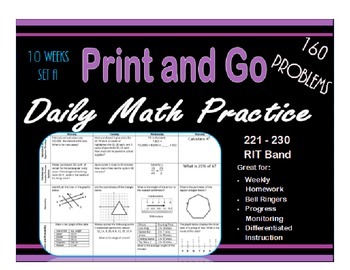Daily Math Practice for RIT Band 221 - 230 Set A
- PDF
What educators are saying
Also included in
- This set of math practice worksheets provides students with daily (Monday through Thursday) math problems based on the skills outlined in NWEA's Learning Continuum for MAP testing. Each day, students solve four problems, one problem per math goal: Operations and Algebraic Thinking Topics CoveredPrice $24.00Original Price $30.00Save $6.00
- This bundle is a combination of 12 products, which comprise 3 bundles. Each product has 10 weeks of practice related to the NWEA's MAP test.Price $70.00Original Price $90.00Save $20.00
Description
This set of math practice worksheets provides students with daily (Monday through Thursday) math problems based on the skills outlined in NWEA's Learning Continuum for MAP testing. Each day, students solve four problems, one problem per math goal:
Operations and Algebraic Thinking Topics Covered
*Single and multi-step word problems with expressions and equations
*Proportions and ratios
*Laws of Exponents and scientific notation
*Properties of arithmetic and order of operations
*Linear expressions, equations, and inequalities
*One-step and two-step linear and quadratic equations
*Systems of equations
*Linear functions, slopes, and initial values in real world scenarios
Real and Complex Number Systems Topics Covered
*Fractions, decimals, and percents with real world problems, equivalency,
and ratios
*Real world problems with rational numbers and time
*Metric and U.S. Customary units of measurement
Geometry Topics Covered
*Ratios, proportions, and scale
*Properties of two- and three-dimensional shapes
*Types of lines - segments, rays, lines, parallel lines, and perpendicular lines
*Types of angles - acute, obtuse, and right
*Types of triangles - equilateral, isosceles, right, and scalene
*Types of translations and coordinates on a plane
*Nets of three-dimensional shapes
*Area and perimeter of quadrilaterals and triangles
*Area and circumference of circles
*Volume of rectangular prism
Statistics and Probability Topics Covered
*Real world problems using line plots, dot plots, histograms, two-way frequency
tables, line graphs scatter plots, bar graphs, and pie charts
*Measures of central tendency and variance real world problem with decimals
and fractions
*Experimental and theoretical probability
*Marginal, conditional, and joint probability
*Simple events and complement events
These practice problems are designed to provide students with a vast exposure to the 221 – 230 RIT Band skills and concepts that they are ready to develop. This resource can be used for a bell ringer, small group instruction, or homework.
Each worksheet has 16 practice problems that builds students’ critical thinking skills and develops their vocabulary. This set includes:
*10 weekly worksheets – 16 practice problems per worksheet, 4 for Monday through Thursday
*10 weekly work mats – for students to show their calculations, draw diagrams, or
construct graphs.
*10 answer keys – 1 for each worksheet
*A teacher math goals monthly tracker
*A student math goals tracker
Save money and purchase the Daily Math Practice Bundle for 221 - 230 RIT Band.
Email me at info@drcrystalbrown.com if you have any questions.
Follow my blog - Dr Crystal Brown for FREE PRODUCTS, instructional ideas, and to connect with other educators.
Thanks!
© 2015 | www.drcrystalbrown.com
All rights reserved by Dr. Crystal Brown.
Permission to copy for single classroom use only.
Electronic distribution limited to single classroom use only.
This is not an NWEA product, nor is it endorsed by NWEA.







